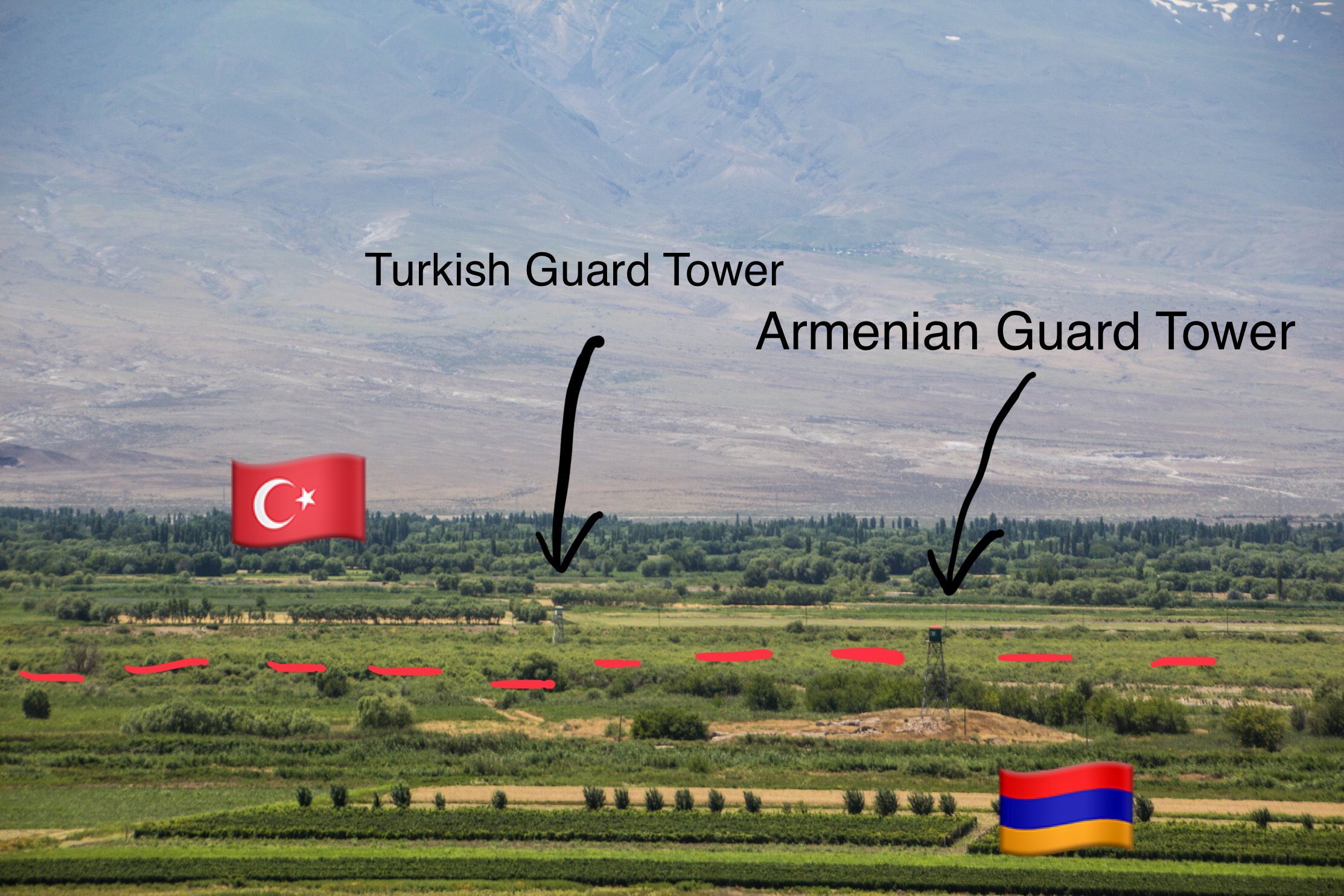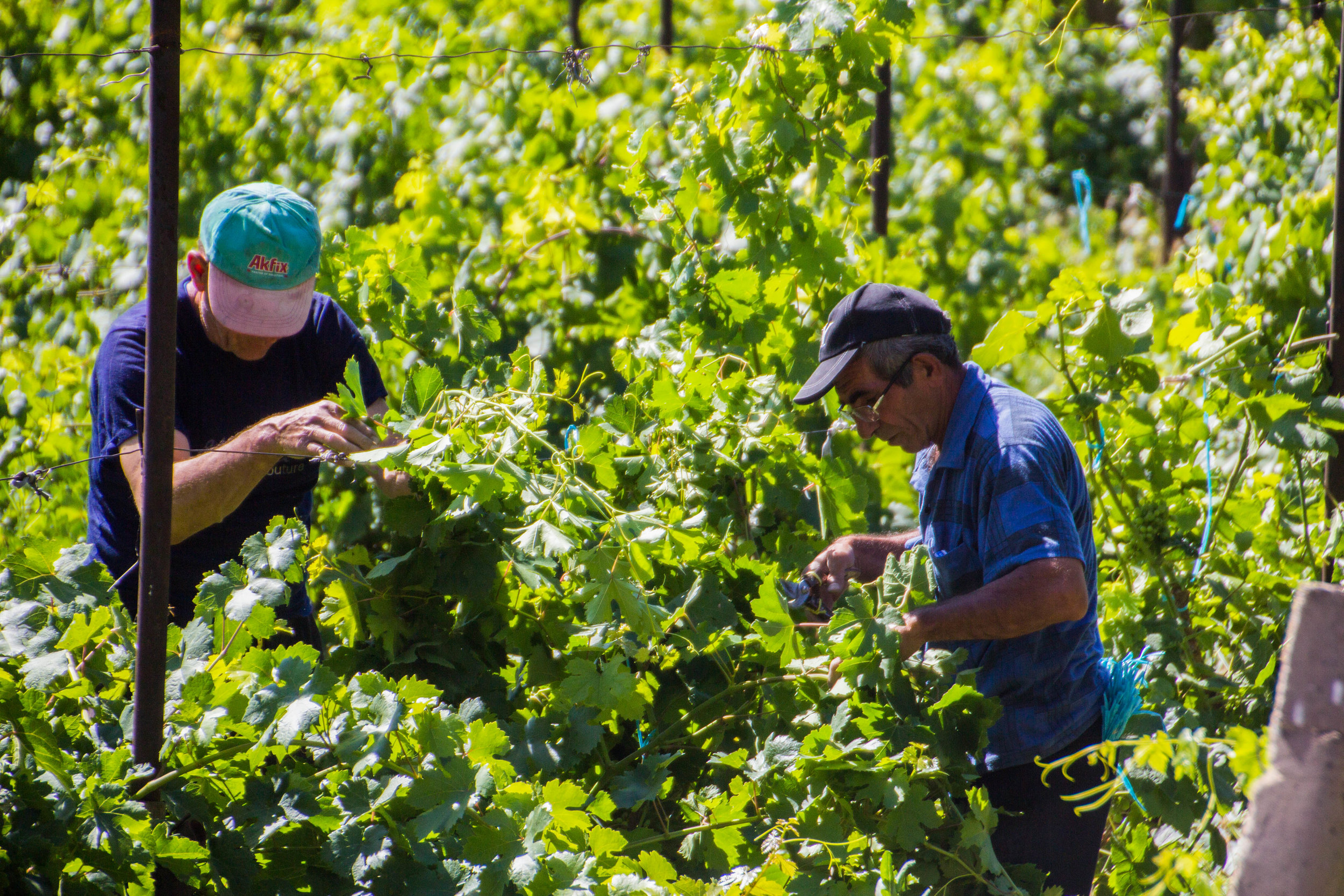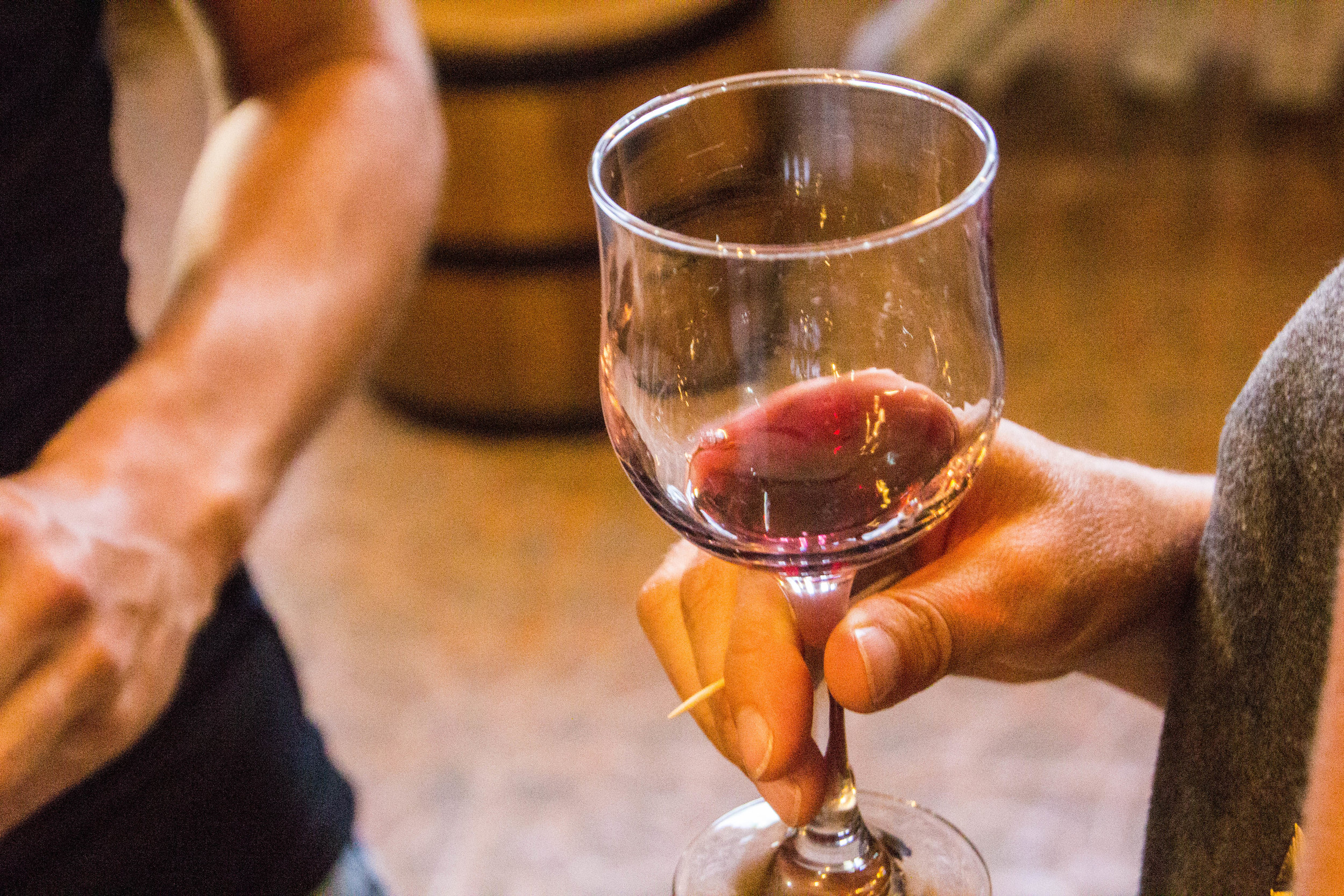For our last installment from Armenia, we’re going to our most famous site yet. Well, maybe it’s a little bit less notable than the Genocide Memorial or the Cascade in Yerevan, but it’s definitely one of the most iconic images of Armenia. Prior to my trip, I knew that if I went nowhere else outside of Yerevan on my trip, I was going to come here.
I’m talking about Khor Virap Monastery.
It’s not exactly a household name, but if you just run a simple Google Images search for Armenia, it’s going to be one of the first things that pops up. And it’s not far from Yerevan! So when I arrived at Envoy Hostel around 11:00am on my first day, the first thing I did was book a spot on a bus that would take me here a couple of days later. And Envoy delivered.
Khor Virap Monastery
Khor Virap was initially built in the year 642 A.D. And then, about 1,000 years later in the year 1662, another larger church building was added to the complex, which still stands as the centrifuge of the site today. Located almost exactly on the Turkish border (just a few kilometers away) and within spitting distance from the base of Mount Ararat, it’s undeniably beautiful. But that’s not why it’s famous.
Khor Virap is most notable as being the place where Gregory the Illuminator was imprisoned for 14-ish years.
What’s that? You don’t know who Gregory the Illuminator is?
Gregory the Illuminator is the dude credited with converting Armenia from paganism to Christianity in 301 A.D. He would go on to be the patron saint and first head of the Armenian Apostolic Church. Today there are statues of him in the Vatican and plaques in every single church across the whole of Armenia (the ones that are old enough to have overlapped with him) saying things like “Gregory came here one time.” He’s a big deal.
So how did he end up in the dungeon of Khor Virap? Well Gregory was actually born into a family that was part of Ancient Armenian nobility. His father was a Prince that was related to the ruling dynasty at the time, but got himself into trouble when he apparently assaulted one of the kings in the region. He was put to death and Gregory—who was still a child at this point—narrowly escaped the same fate. He was brought to Cappadocia (Turkey) where he grew up, married, had children, and became a Christian. Eventually, as an adult, he left that family to come back to Armenia to spread the Christian gospel. At this point the son of the King that killed Gregory’s father had, himself, become king. His name was King Tiridates III, and when he found out the Gregory was back in town, he had him thrown into a random dungeon in the middle of nowhere and left for dead.
Now, this was a few hundred years before Khor Virap was built, but when it finally was built, it was built around this dungeon. I think there was a small building on top of the dungeon that was absorbed into the architecture. This means that you can actually go down into the original dungeon where Gregory was held. You’ll see below that they’ve installed a ladder and some lighting, but neither of these things would have been present in Gregory’s time. He was literally thrown down this hole where the ladder is today. Let me tell you, this is a long ladder. I was getting the palm sweats going down into this little hell hole. To be thrown down this thing could easily kill somebody. Gregory survived the fall… but he must have had a few broken bones! You’ll see a few pictures of the space below. Picture that space, but with no ladder or candle. Just total blackness.
So Gregory the Illuminator stayed down here for 14-ish years. Think about that amount of time. I’m writing this in 2019, so if you got thrown into this pit tomorrow, you wouldn’t get out until 2033. If ever. King Tiridates III’s plan was to leave Gregory for dead down here with no food or water, but apparently there was a woman in a nearby village who heard Gregory’s cries, and started bringing him bread and water everyday. Everyday for 14 years. How’s that for a random act of kindness? This place is in the middle of nowhere today; I can only imagine that that was even more the case in ancient times.
Anyway, you already know that Gregory is destined to get out of here and change the course of Armenian history. How did that happen exactly? Well about 14 years later King Tiridates III falls ill with some sort of mysterious disease. Wikipedia says he was going insane after losing a ton of territory to the Roman Empire, but the description given at Khor Virap makes it sound more severe than just that. They say he was starting to look and behave like a wild boar… 🤷🏻♀️Anyway, somebody in his cabinet (who had been apparently been uneasy about Gregory’s imprisonment in the first place) suggested that they go see if Gregory was still alive, since he might be able to cure him. They go back to this pit where they had left him for dead and, miraculously, he was still alive. They got him out, he cured Tiridates, and the rest is history.
ANYWAY, here are a few pictures from around Khor Virap! It’s a very pretty setting, although it’s pretty far from anything. Mount Ararat is particularly imposing from this close vantage point. The surrounding terrain is dry and earthy, kind of like Southern California, but there are green, agricultural fields stretching occupying all flat-ish land that stretch off into the distance in every direction.
To give you an idea of just how close this is to Turkey, I went ahead a doctored up a photo that took from the ridge behind Khor Virap. In the distance you can see two guard towers facing each other. The closer one is an Armenian guard tower, and the white one that is further away is Turkish. And in the middle there are at least a few meters of no man’s land, as is typical between these types of borders.
Remember that, even though there is no active conflict between these two nations, the border between Armenia and Turkey is closed. If you want to drive from Armenia to Turkey, you have to go through Georgia or Iran. So this is a tense-ish area. Obviously the border(s) with Azerbaijan is what takes up the most headspace for Armenia, but this one has some awful history behind it as well. If you missed my article on the Armenian Genocide, you can skip over to that here.
From there, we climbed back down to ground level, exiting through the hot, crowded parking lot. It was mid-morning, and the temperature was already climbing fast. I stopped under an umbrella to buy a packaged ice cream cone out of a freezer for about $0.02. This is one of those details that weirdly confirms Armenia’s place in the “Central Asia” category of this blog. My little brother (who I will be joining starting in the next article) had just traveled from Western China, across almost all of the -stans, and he said these packaged ice cream cones were one of the few thing that were totally ubiquitous across all the former Soviet Republics. And also marshrutkas of course, which we will talk all about once we get to Georgia. But he said there is one of these ice cream cone sellers on every street corner from Kashgar to Ashgabat. It’s the little things that define a place.
Anyway, before we left Khor Virap completely in the dust, we made one roadside stop to take pictures. This vantage point was roughly the same as the famous photo you’ll see plastered all over Armenia’s sphere of the internet. When we pulled off to the side of the road, I decided it would be a good idea to the hurdle the babbling brook the flowed alongside the pavement in order to get a better shot. I almost made it across, but I ended up with one entire leg covered in thick mud. Ya gotta do it for the ‘gram! In the foreground of the picture below you’ll see vineyards. I think pulling myself out of this little creek and emerging into this vineyard was the first time that I really processed the fact that I was in wine country. More on this in a moment, but first, check this out:
🍇 Armenia’s Winelands 🍷
Spoiler alert: this series on the Caucasus involves a LOT of wine. Just wait til we get to Georgia 😅
Today we generally think of places like Italy, France, Chile, Argentina, and California as the premiere winemaking regions of the world. But the OG wine country was actually right here in the Caucasus. In fact, the world’s oldest winery was just recently discovered in Armenia! It’s more than 6,000 years old. Indeed, the Caucasus region is known to be the birthplace of wine, but winemaking here is only just coming back into style! This region has had a rough go of things the last few hundred years so winemaking has had to take a backseat. But now that these tiny countries are getting back on their feet, winemaking is coming back into fashion. Armenia is barely known at all, let alone for its wine, but there are some winemakers here that are already starting to make waves!
ANYWAY, there I was, standing on the edge of an Armenian vineyard, one leg completely coated in wet mud. I did some hiking through the vineyard and found a way back onto the road that did not require me to hurdle a small river, and then I apologetically crawled back into the van. Our next destination was lunch. The folks running the Envoy tour had arranged for a local family to take us into their home and feed us. Our hosts that day were a 60-something-year-old Armenian couple. When we emerged into their sunny courtyard, the husband graciously showed me to the water spigot that I so desperately needed. While my muddy shoes sat drying in the sun, I entered the house with the rest of our crew, a beat-up pair of Armenian old-man sandals on my feet. Here are a few pictures from that house…
See all those awesome pictures on the wall? Apparently this couple were both artists! The wife did the painted stills that you’ll see up there, and the husband did the sketched portraits. Fun fact: my mother trained as a painter and has been a working artist my whole life, so I grew up with a lot of this swirling around me. I wouldn’t consider myself to be an artist of the visual variety (except with a camera I guess?) but I have definitely developed an appreciation for this stuff! So when I saw these paintings through a cracked door, off to the side of the dining room, I had to go in. Honestly I loved their work! I snapped a few pictures of it.
Just then, the husband walked in with a smile on his face. I asked him who did all these pieces and he explained that it was him and his wife. Then he took me to a sketch hanging on the wall and told me that it was a self-portrait that he had done in… I want to say 1975? It was sometime in the late 70s. I took a quick picture of him next to the portrait. Obviously he’s many years older now.
For the life of me, I cannot remember this guys name! It’s a shame because this little house was one of my favorite moments in my trip to Armenia. The food they served was excellent (if you couldn’t have guessed from the picture of the dining room table above), and their courtyard was incredible! I don’t know what I expected from Armenia, but I didn’t think it would have such a Mediterranean feel to it. This courtyard was gorgeous and sunny, and surrounded on all sides by miles of vineyards. If you dropped me here and made me guess where I was, I probably would have said Sicily or Greece. It was the real deal! We sat at a shaded table outside and were served a combination of coffee and tea. When we were done, I collected my now mostly dry and clean shoes, thanked our hosts, and followed my group back out to our ride.
Here are a couple snapshots from vineyards around this area…
Our last stop in this article is going to be an Armenian winery. I don’t remember what it was called, but it wasn’t anything to write home about. We did a wine tasting here, and it was all pretty good! It was just a little ghetto. It was a family run place, and before the tastings, there were some varieties of wine that they were literally pouring out of plastic water bottles. It was funny.
In between tastings, I ended up in a conversation with one of the teenagers behind the bar. He spoke flawless English in an American accent. It caught me off guard. I was, after all, in the middle of absolute nowhere. I asked him how his English was so good, and he told me that he had studied abroad in the U.S. I asked him where, and he told me that it was a town in Oklahoma, near the Kansas border. Which, like, is honestly pretty remote! I’ve never been anywhere near there and I doubt many other Americans have either. This kid definitely did not understand that that should have been a pretty interesting experience… he just said it was boring. Then again, I’m sure small towns are pretty much the same everywhere you go in the U.S. 🤷🏻♀️
Here are a few shots from the wine tasting…
This winery was way out near the arid desert-scape that we explored in our last article. The vineyards pretty much extended as far out into the desert as could reasonably sustain any sort of irrigation. And as we drove through this dusty transition zone, where wine lands meet desert, we began to see unmarked bottles of dark liquid appear at the roadside stands that we would pass. I didn’t think much of them, but it was later explained to me that these are plastic Coca-Cola bottles with the wrappers torn off, filled with red wine. They are sold here along the roadside so that long-haul truckers on their way to Iran can purchase them. Remember, Iran is extremely Muslim, which means that alcohol is not common. So these truckers will basically smuggle these bottles of wine over the border into Iran from here. I thought that was interesting.
Here’s one last fun fact: Armenia is the only country in the world that has good relations with the U.S., Iran, AND Russia. Again, I just thought that was interesting.
I don’t have a clever segue here, but that’s the end of this series on Armenia! I loved this country and everybody I met in it, and I will be evangelizing it for years to come. But now it’s time to move on.
Next stop, Georgia!
…the country 🤦🏻♂️





































